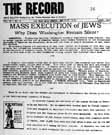
|
|
|

|

|

|

|
|
Click on an image to see a larger, more detailed picture.
|
|
|
|
|
| 1942: The "Final Solution" |

|
pg. 337 |

|
|
|
|
| |
 The news bulletin of the United Romanian Jews of America published reports of atrocities committed against Romanian Jewry as early as June 1942. Printed in New York City and distributed throughout the United States, the headline proclaimed the "Mass Execution of Jews" and queried the government's policy of silence. Pleas such as this were typical of Jewish organizations throughout the United States.
The news bulletin of the United Romanian Jews of America published reports of atrocities committed against Romanian Jewry as early as June 1942. Printed in New York City and distributed throughout the United States, the headline proclaimed the "Mass Execution of Jews" and queried the government's policy of silence. Pleas such as this were typical of Jewish organizations throughout the United States.
Photo: United States Holocaust Memorial Museum Photo Archive
|
 As his comrades look on, a German soldier offers food to a barefoot and hungry Croatian child. Axis military victory led to the division of Yugoslavia. Croatia became a Nazi puppet state, led by the Ustasa. The Ustasa persecuted any who opposed them, including Serbs, leaving those fortunate enough to survive hungry and homeless.
As his comrades look on, a German soldier offers food to a barefoot and hungry Croatian child. Axis military victory led to the division of Yugoslavia. Croatia became a Nazi puppet state, led by the Ustasa. The Ustasa persecuted any who opposed them, including Serbs, leaving those fortunate enough to survive hungry and homeless.
Photo: Lydia Chagoll / United States Holocaust Memorial Museum Photo Archive
|
 Deportations in France
Deportations in France
The treatment of French Jews at the hands of the Nazis offers a poignant reminder of the fragile nature of democracy. Though French Jews were emancipated in 1790 and well integrated into the fabric of French society on the eve of World War II, their fate was altered dramatically in 1942. Beginning in the summer Jews in France were rounded up and deported to the East, where they were executed. The roundups that began on July 16, 1942, targeted mostly stateless and foreign-born Jews, though British and American Jews were exempt from the operation. Those who were caught in the first wave were interned in the Paris sports arena known as the Vélodrome d'Hiver. With 7000 people packed into the arena, a facility that lacked food, water, and sanitary facilities, the conditions were horrible. Internees were confined for several days before being deported. From the Vélodrome d'Hiver, Jews were deported to Drancy (a camp in the suburbs of Paris) or other temporary internment centers before being shipped to Auschwitz. In all, at least 77,000 Jews from France were murdered during the Holocaust, including Henri Sznajderman and his mother (both pictured). Most died at Auschwitz, while others were killed at Majdanek and Sobibór or while in detention.
Photo: Serge Klarsfeld/United States Holocaust Memorial Museum Photo Archive
|
|

|

|

|

|
 July 14, 1942: Thousands of Dutch Jews are arrested in Amsterdam and deported to Auschwitz, where many are gassed.
July 14, 1942: Thousands of Dutch Jews are arrested in Amsterdam and deported to Auschwitz, where many are gassed.
|
 July 14, 1942: The Przemysl, Poland, ghetto is sealed by the Nazis.
July 14, 1942: The Przemysl, Poland, ghetto is sealed by the Nazis.
|
 July 15, 1942: The first deportation train leaves Holland (from the Westerbork transit camp) for Auschwitz.
July 15, 1942: The first deportation train leaves Holland (from the Westerbork transit camp) for Auschwitz.
|
 July 16, 1942: La Grande Rafle ("The Big Sweep") commences in Paris, as the German and Austrian Jews living in the city, about 13,000 total, are rounded up; See July 19, 1942.
July 16, 1942: La Grande Rafle ("The Big Sweep") commences in Paris, as the German and Austrian Jews living in the city, about 13,000 total, are rounded up; See July 19, 1942.
|
 July 17, 1942: A Nazi delegation headed by SS chief Heinrich Himmler tours the death camp at Auschwitz, where Himmler observes a mass gassing of inmates.
July 17, 1942: A Nazi delegation headed by SS chief Heinrich Himmler tours the death camp at Auschwitz, where Himmler observes a mass gassing of inmates.
|
 July 19, 1942: Deportations to the Auschwitz death camp begin for Parisian Jews who have been held at Drancy, France, since July 16.
July 19, 1942: Deportations to the Auschwitz death camp begin for Parisian Jews who have been held at Drancy, France, since July 16.
|
 July 19, 1942: SS chief Heinrich Himmler orders that all Polish Jews in the Generalgouvernement be deported eastward by December 31, 1942.
July 19, 1942: SS chief Heinrich Himmler orders that all Polish Jews in the Generalgouvernement be deported eastward by December 31, 1942.
|
|
|
|
|
| 1942: The "Final Solution" |

|
pg. 337 |

|
|
The Holocaust Chronicle
© 2009 Publications International, Ltd.
|
|
